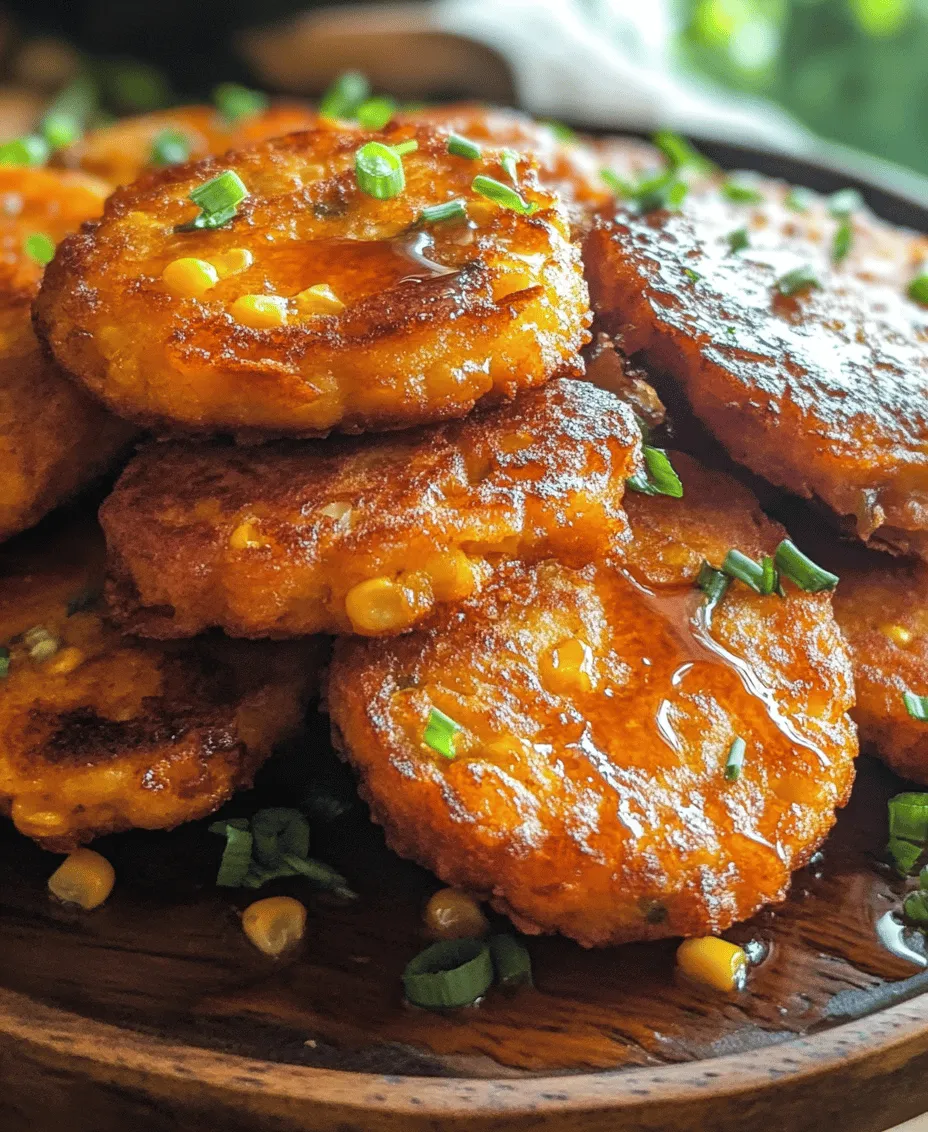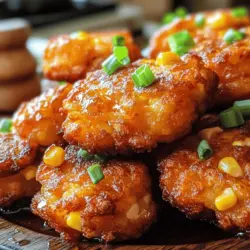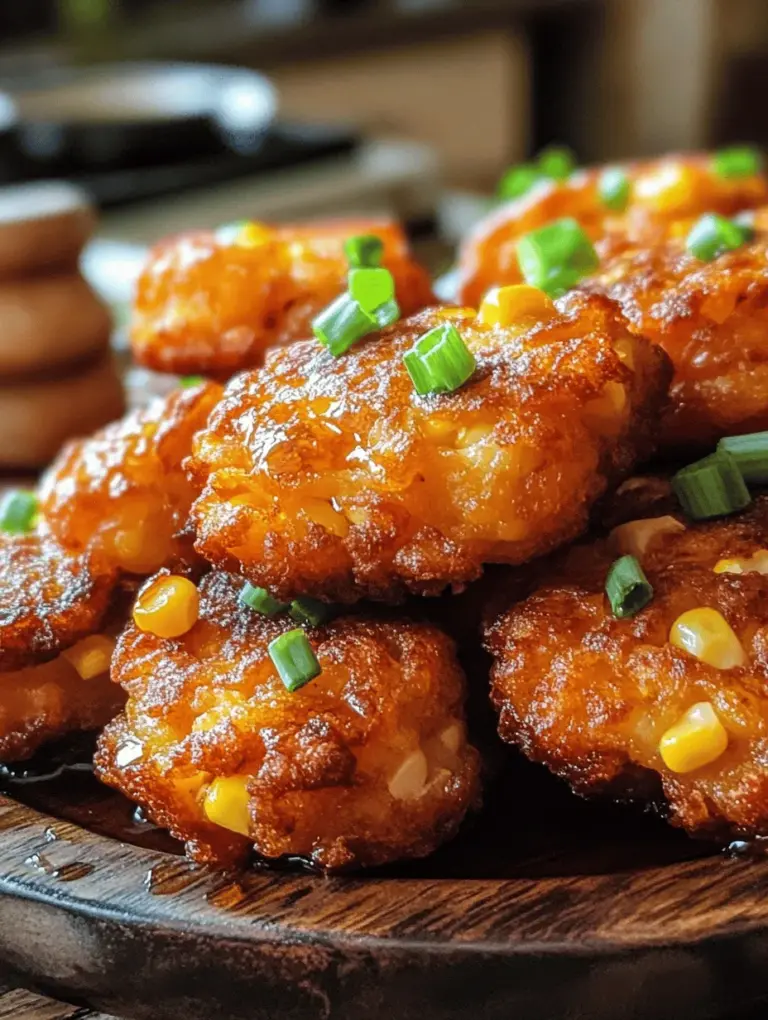Introduction
Crispy fried cornbread fritters are a beloved comfort food that embodies the essence of Southern cooking. These delectable morsels boast a crunchy exterior that gives way to a soft, flavorful interior, making them a satisfying addition to any meal. Whether served as an appetizer at a gathering or as a side dish alongside a hearty main course, cornbread fritters are sure to please crowds and elevate family dinners alike.
What makes cornbread fritters so appealing is their versatility. Infused with sweet corn, they offer a delightful balance of flavors that can be customized to suit any palate. Add herbs, spices, or even cheese to create a dish that perfectly complements your taste preferences. Beyond their mouthwatering taste, the simplicity of the recipe ensures that even novice cooks can whip them up with ease, making them a go-to choice for last-minute gatherings or potlucks.
Understanding Cornbread Fritters
Cornbread fritters are essentially small, round cakes made from a batter that incorporates cornmeal, flour, and various other ingredients. They can be deep-fried or pan-fried until golden brown, resulting in a crispy texture that contrasts beautifully with the tender corn mixture inside. The origin of cornbread fritters can be traced back to Native American cuisine, where corn was a staple ingredient. Over time, this dish evolved into a popular Southern delicacy, with countless regional variations emerging across the United States.
One of the key nutritional benefits of cornbread fritters lies in their primary ingredient: cornmeal. Full of fiber, vitamins, and minerals, cornmeal provides a hearty base that can contribute positively to a balanced diet. Additionally, corn kernels add natural sweetness and texture, making these fritters not only delicious but also nourishing.
Regional variations of cornbread fritters abound. In the Southern United States, you might find them flavored with jalapeños or served alongside a spicy dipping sauce. In other areas, cheddar cheese or fresh herbs might be folded into the batter, giving each batch its unique twist. Regardless of the variation, cornbread fritters remain a cherished dish that brings people together.
Ingredient Breakdown
To create the perfect crispy fried cornbread fritters, it’s essential to understand the role and benefits of each ingredient in the recipe.
Cornmeal
Cornmeal is the star ingredient of this recipe. It comes in various types, including yellow, white, and blue cornmeal. Each type brings its unique flavor and color to the fritters. Yellow cornmeal is the most common and offers a slightly sweet taste. Nutritionally, cornmeal is high in fiber, which aids digestion, and it contains essential minerals like iron and magnesium. When selecting cornmeal, opt for stone-ground varieties for a more robust texture and flavor.
All-Purpose Flour
All-purpose flour serves as a binding agent in cornbread fritters, helping to achieve the desired texture. It provides structure to the fritters, ensuring they hold together during frying. While all-purpose flour is commonly used, you can experiment with alternative flours, such as whole wheat or gluten-free blends, to accommodate dietary preferences.
Baking Powder
Baking powder plays a vital role in leavening the fritters. When mixed with the wet ingredients, it creates carbon dioxide bubbles, giving the batter a light and airy quality. This results in fritters that are not only crispy on the outside but also fluffy on the inside.
Buttermilk
Buttermilk is another key ingredient that adds moisture and richness to the fritters. Its tangy flavor complements the sweetness of the corn, enhancing the overall taste of the dish. If you don’t have buttermilk on hand, you can easily create a substitute by mixing milk with a splash of vinegar or lemon juice.
Eggs
Eggs act as a binding agent, helping to hold the fritters together while also adding richness to the batter. They contribute to the overall texture, ensuring that the fritters are tender and not too dense.
Fresh vs. Frozen vs. Canned Corn
When it comes to corn, you have several options to choose from: fresh, frozen, or canned corn. Fresh corn is the most flavorful and provides the best texture, but it requires more preparation. Frozen corn offers convenience and retains much of its flavor, making it an excellent choice for quick recipes. Canned corn is also a viable option; however, be sure to drain it well to avoid excess moisture in the batter.
Green Onions
Green onions add a pop of color and a mild onion flavor to the fritters. Their freshness elevates the overall taste of the dish and provides a nice contrast to the sweetness of the corn. Feel free to adjust the amount based on your preference or substitute with chives for a milder flavor.
Cheese Options
Incorporating cheese into your cornbread fritters can take them to the next level. Cheddar cheese is a popular choice, adding a sharp flavor that complements the sweetness of the corn. Other options include feta for a salty kick or pepper jack for those who enjoy a little heat. Be creative and experiment with your favorite cheeses to personalize the recipe.
Vegetable Oil
For frying the fritters, the choice of vegetable oil is crucial. Oils with high smoke points, such as canola or peanut oil, are ideal for frying as they can withstand higher temperatures without burning. A neutral oil will allow the flavors of the fritters to shine without overpowering them.
Step-by-Step Instructions
Now that we’ve explored the background and ingredients of crispy fried cornbread fritters, let’s dive into the preparation process. Follow these step-by-step instructions to create the perfect fritters:
Preparation of the Dry Mixture
Begin by gathering your dry ingredients. In a large mixing bowl, combine the cornmeal, all-purpose flour, baking powder, and a pinch of salt. Whisk them together until well blended, ensuring there are no lumps. This dry mixture forms the foundation of your fritters, so take care to incorporate the ingredients evenly.
Combining Wet Ingredients
In a separate bowl, combine the buttermilk and eggs. Whisk the mixture until fully combined, then slowly pour it into the dry ingredients. It’s important to mix the ingredients gently to avoid overmixing, which can lead to dense fritters. Stir until just combined; a few lumps are okay.
Incorporating Additional Ingredients
Next, fold in the fresh or frozen corn, chopped green onions, and any cheese you’ve chosen to use. Use a spatula to incorporate these ingredients into the batter, ensuring even distribution. The batter should be thick but not overly stiff; it should hold together without being too dry.
Achieving the Right Batter Consistency
At this point, assess the consistency of your batter. If it seems too thick, you can add a splash more buttermilk to loosen it up. Aim for a batter that is scoopable and holds its shape when dropped into the hot oil. This consistency is key for achieving the perfect fritter shape during frying.
Frying Techniques for Perfect Fritters
To fry the fritters, heat about an inch of vegetable oil in a heavy skillet or frying pan over medium-high heat. To test if the oil is ready, drop a small spoonful of batter into the oil; it should sizzle immediately and float to the surface. Once the oil is hot enough, use a spoon or small ice cream scoop to drop dollops of the batter into the oil, taking care not to overcrowd the pan.
Fry the fritters for about 3-4 minutes on each side or until they turn golden brown and crispy. Once cooked, transfer them to a paper towel-lined plate to drain any excess oil. Repeat the process until all the batter is used, adjusting the heat as necessary to maintain optimal frying temperature.
By following these instructions, you will create crispy fried cornbread fritters that are sure to impress. In the next section, we will explore tips for achieving the best results and address common questions about this delightful dish.

Importance of Oil Temperature
When frying cornbread fritters, achieving the perfect oil temperature is crucial. The ideal frying temperature for these fritters is between 350°F to 375°F (175°C to 190°C). At this temperature, the fritters will cook evenly, develop a crispy exterior, and prevent excess oil from being absorbed. If the oil is too hot, the outside of the fritters may burn while the inside remains undercooked. Conversely, if the oil is too cold, the fritters will absorb more oil, resulting in greasy, soggy fritters.
To check the oil temperature, use a deep-fry thermometer. If you don’t have one, you can drop a small amount of batter into the oil; if it sizzles and rises to the surface immediately, the oil is ready. Another tip is to add a wooden spoon to the oil; if bubbles form around the spoon, the oil is at the right temperature for frying.
How to Avoid Overcrowding the Pan
Overcrowding the pan is a common mistake when frying fritters. If there are too many fritters in the oil, the temperature will drop significantly, leading to uneven cooking and greasy results. To ensure the best outcome, fry the fritters in small batches. Depending on the size of your frying pan, this typically means cooking only three to five fritters at a time.
By allowing enough space for each fritter, hot oil can circulate freely around them, ensuring they cook evenly and achieve that desirable golden brown color. If you find that you have to fry a large batch, consider using multiple pans or frying in shifts to maintain an even temperature throughout the cooking process.
Tips for Ensuring Even Cooking and Achieving Golden Brown Color
To achieve perfectly golden brown cornbread fritters, follow these tips:
1. Consistent Sized Fritters: When scooping the batter, try to make each fritter the same size. This will help them cook evenly. Using a cookie scoop or an ice cream scoop can ensure uniformity.
2. Monitor Cooking Time: Keep an eye on the fritters as they cook. They typically need about 3 to 4 minutes on each side. Flip them gently with a slotted spoon or spatula when the underside is golden brown.
3. Use Fresh Oil: If you’ve been frying for a while, the oil may start to break down and lose its frying capabilities. Replace or replenish the oil as needed to maintain that ideal frying temperature and ensure crispiness.
4. Drain Excess Oil: After frying, place the fritters on a plate lined with paper towels to absorb any excess oil. This step is essential for keeping the fritters crisp.
Serving Suggestions
Crispy fried cornbread fritters are incredibly versatile and can be served in various ways. Here are some delightful accompaniments and serving suggestions:
Recommended Accompaniments
1. Honey: A drizzle of honey elevates the flavor of cornbread fritters beautifully. The sweetness of honey complements the savory corn and adds a touch of indulgence.
2. Dipping Sauces: Consider serving fritters with a variety of dipping sauces to cater to different tastes. Some popular options include:
– Spicy Mayo: A simple mixture of mayonnaise and hot sauce adds a creamy and spicy kick.
– Chipotle Aioli: A smoky, garlicky sauce pairs wonderfully with the fritters.
– Sour Cream or Greek Yogurt: These provide a cool contrast to the warm fritters.
3. Appetizer or Side Dish: Serve the fritters as an appetizer at gatherings or as a side dish alongside grilled meats, salads, or soups. They can even be included in a tapas-style meal, allowing guests to sample a variety of flavors.
Storage and Reheating Tips
To enjoy your cornbread fritters beyond the initial fry, proper storage and reheating techniques are essential.
Best Practices for Storing Leftover Fritters
– Allow the fritters to cool completely before storing them to prevent moisture buildup, which can make them soggy.
– Place them in an airtight container lined with paper towels to absorb any excess grease.
– Store the fritters in the refrigerator for up to 3 days. For longer storage, consider freezing them.
How to Reheat Fritters While Maintaining Their Crispiness
– Oven Method: Preheat your oven to 375°F (190°C). Arrange the fritters in a single layer on a baking sheet and reheat for about 10-15 minutes, or until they are heated through and crispy again.
– Air Fryer Method: If you have an air fryer, this is an excellent option for reheating. Set it to 350°F (175°C) and heat the fritters for about 5-7 minutes, checking to ensure they don’t overcook.
Common Mistakes to Avoid
Even seasoned cooks can make a few missteps when preparing cornbread fritters. Here are some common mistakes to watch out for:
Overmixing the Batter and Its Effects on Texture
When mixing your fritter batter, be careful not to overmix. Overmixing can result in a dense, tough texture instead of the light and airy fritters you desire. Mix just until the ingredients are combined, and small lumps remain; this will yield a fluffier final product.
Incorrect Oil Temperature: Signs of Too Hot or Too Cold
As mentioned earlier, maintaining the correct oil temperature is critical. If the oil is too hot, the fritters will cook too quickly and burn on the outside while remaining raw inside. Signs of oil being too hot include excessive smoking or a rapid bubbling of oil. Conversely, if the oil is too cold, the fritters will sink and absorb too much oil, making them greasy. Look for a steady, gentle bubbling when frying.
Frying Too Many Fritters at Once and How It Affects Cooking
Avoid the temptation to fry a large batch all at once. As highlighted before, frying too many fritters at once can lead to overcrowding, which results in uneven cooking and soggy fritters. Always prioritize small batches to maintain oil temperature and achieve that perfect golden brown finish.
Exploring Variations and Additions
Crispy fried cornbread fritters are a blank canvas, allowing you to unleash your creativity in the kitchen. Here are some ideas for spicing up your fritters:
Ideas for Spicing Up the Recipe
1. Adding Jalapeños for Heat: Incorporating diced jalapeños into the batter can add a nice kick for those who enjoy spicy foods. Adjust the amount based on your heat preference.
2. Incorporating Herbs for Freshness: Fresh herbs like cilantro, chives, or parsley can brighten the flavor of the fritters. Simply fold them into the batter before frying for a refreshing twist.
3. Substituting Different Cheeses: Experiment with different types of cheese to cater to various taste preferences. Cheddar, feta, or pepper jack can all add unique flavors to your fritters.
4. Vegan or Gluten-Free Adaptations: For a vegan version, substitute eggs with flax eggs or applesauce and use a gluten-free flour blend to accommodate those with dietary restrictions. These adaptations allow everyone to enjoy this delicious dish.
Conclusion
Crispy fried cornbread fritters are a delightful addition to any meal, offering a perfect balance of texture and flavor. Their versatility allows them to shine as a snack, appetizer, or side dish, making them a favorite in comfort food culture. Whether enjoyed plain, with honey, or paired with zesty dipping sauces, these fritters are sure to please any palate.
We encourage you to try this recipe and experiment with your own variations. Share your experiences, tips, and creative ideas with friends and family. The beauty of cooking lies in its potential for creativity and connection, and these cornbread fritters are an excellent way to bring people together around the table. Enjoy the process and relish every delicious bite!


